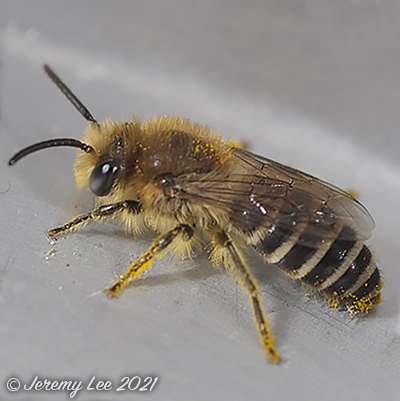
 |
|
Scientific Classifications explained » Amphibians » Ants » Aphids » Bees » Beetles » Birds » Bugs » Butterflies » Caterpillars » Damselflies » Dragonflies » Earwigs » Flies » Frog/Leafhoppers » Fungi » Galls » Grasshoppers » Harvestmen » Hoverflies » Lacewings » Ladybirds » Leaf Mines » Lichens » Mammals » Millipedes » Mosses » Moths » Sawflies » Slugs » Snails » Spiders » Trees » Wasps » Wild Flowers » Woodlice |
UK Nature > Bees > Colletes similis

Scientific Name: Colletes similis Common Name: Plasterer Bee Colletes similis is a medium-small species rather resembling C. fodiens in the field. Females have a much darker first tergite without the long hairs and extensive markings of C.fodiens, and the face is less densely-haired. C.marginatus females are smaller and darker-looking with the face even less dense haired than C.similis. Males (one pictured above) are easily distinguished from other Colletes species by the 'chrysanthemum' pattern of short hairs on the hind margin of sternite 3. Sternite 6 resembles that of C. fodiens, in having shallow depressions and lateral tufts of short hairs. C. similis is a southern species (extending north to Lancashire), fairly frequent in some districts but decidedly scarce in others. It uses quite a broad range of habitats, including coastal dunes, vegetated shingle, soft-rock cliffs, heathland and chalk grassland. There is a heavy reliance on brownfield sites in some areas (often occurring alongside C.daviesanus). Pollen is obtained mainly from Asteraceae, though other flowers such as umbellifers are used as nectar sources. Nesting occurs in small aggregations and it does not seem to often attain the abundance of species such as C.fodiens and C.daviesanus. Adults fly from June till September. |
|

https://www.uknature.co.uk is a website dedicated to showing the immense diversity of UK nature and wildlife. Our vast range of habitats, from lowland arable to snow covered mountains, from storm-ravaged coastlines to peaceful inland freshwater lakes and rivers, from dry, sandy heaths to deciduous and coniferous forests, all these habitats contribute to the abundance of UK nature. We have wild birds in huge numbers either residing or visiting our shores (597 recorded species as at July 2013) and we must also not forget the humble back garden with its grass lawns, flower beds filled with nectar rich flowers, shrubs and trees, all designed to attract huge numbers of insects such as bees, moths, butterflies and hoverflies; and finally the small ponds which provide safe havens for frogs, toads, newts and even slow worms and grass snakes. www.uknature.co.uk is the showcase for my personal passion, photographing uknature in all its glory. I sincerely hope you all enjoy the fruits of my labours. This site and all images contained therein is © Jeremy Lee 2004 - 2021. All Rights Reserved. Site design by Jeremy Lee. Site development & IT Support by Stuart Lee. |